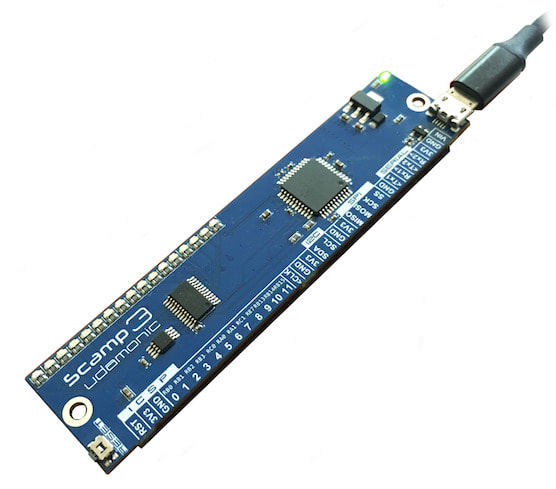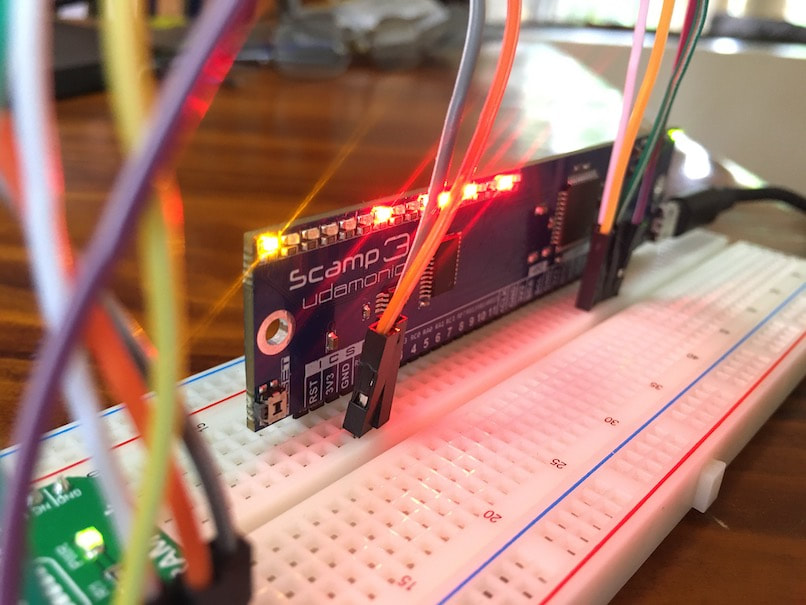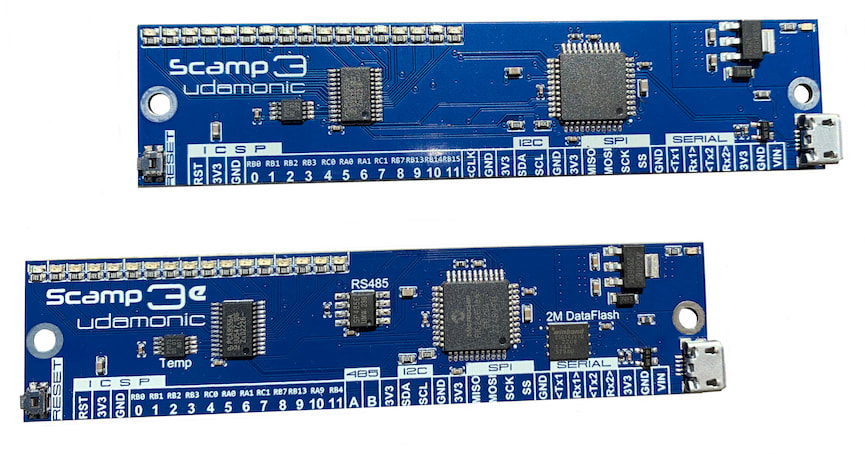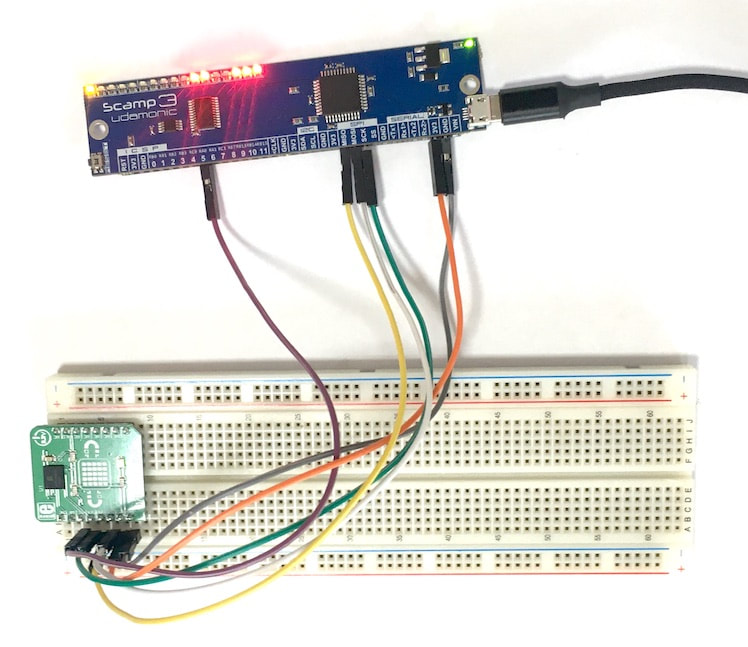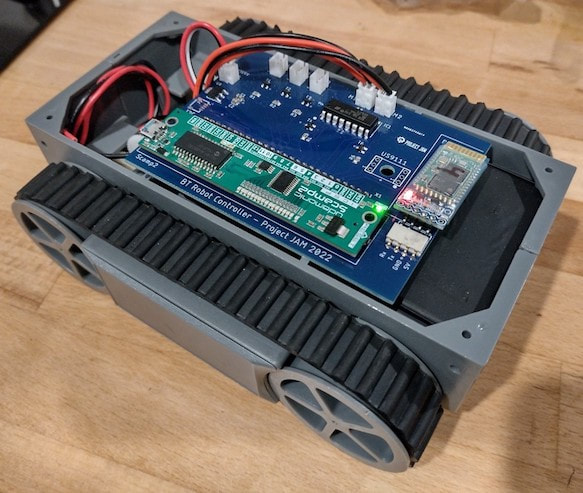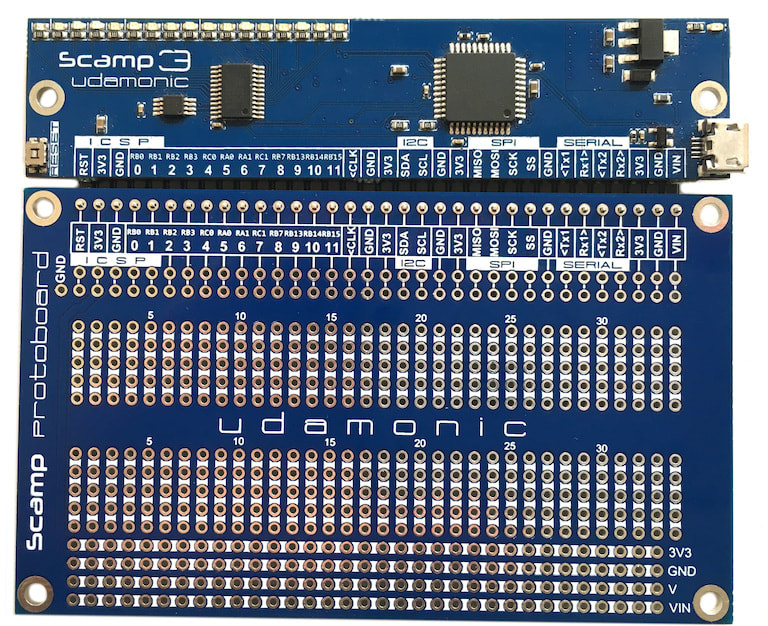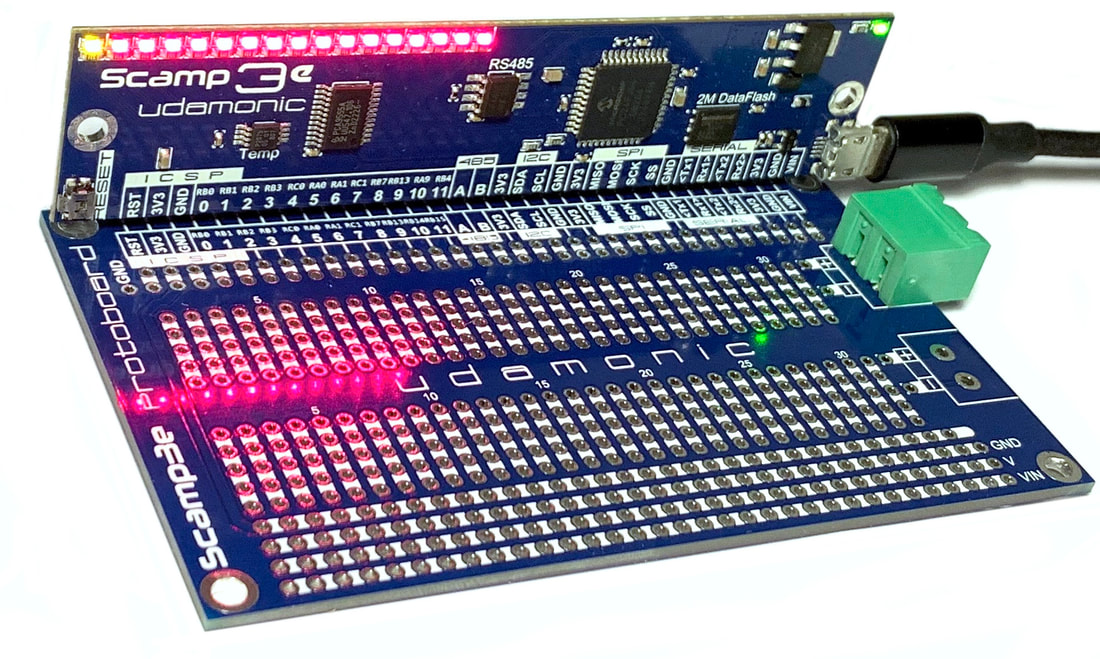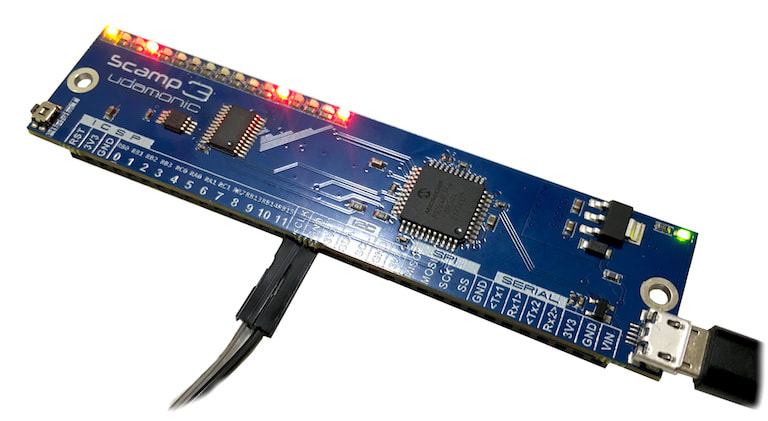What is a Scamp?
|
Scamp has an I/O connector that makes it very easy to interface to external devices. You can add switches, buttons, control knobs, LEDs, and other electronics modules just by plugging them in. It can be interfaced to many of the modules that are available for Arduinos and similar embedded systems. Writing software to use other hardware is very easy, and fun. You can interactively talk with peripheral hardware, so debugging is very fast and efficient. You can see what is going on. |
Interact directly with hardware. Debug in real time. Code in a tiny footprint that runs on the metal. Develop the way you want. This is Embedded the way it's supposed to be.
Scamp is a self-contained Forth computer that you can use as the computing engine for your projects. It's easy to interface, and easy and quick to program using Forth, the world's best embedded programming language. To use a Scamp, you don't need to install any IDEs, compilers or development tools. FlashForth is preinstalled. Everything runs directly on Scamp, and all you need is a host computer with a USB interface and some terminal software. It's used in schools and universities for research or teaching. It's used in home projects by hobbyists. Companies use Scamp in product development to rapidly prototype and debug their own hardware, or as the controller core of their next product. |
Capabilities
The Scamp is a versatile and feature-rich platform for embedded systems development. With its impressive specifications, it opens up a wide range of possibilities for various applications. Let's break down its key features and explore some potential use cases:
|
USB Console
The USB console provides a convenient interface for interacting with the Scamp, making it Forth accessible for both development and debugging. GPIO (General-Purpose Input/Output) GPIO pins offer flexibility for interfacing with external devices and sensors, expanding the range of applications, from robotics to sensor data acquisition. UARTs Multiple UARTs are useful for communication with other devices, sensors, or modules. For example, you could interface with GPS modules, RFID readers, LoRa/BT/WiFi modules, satellite modems or other microcontrollers. Multi Channel ADC The ADC allows you to convert analog signals from sensors into digital data, enabling measurements and data acquisition for various purposes, such as environmental monitoring or sensor networks. I2C and SPI These communication interfaces are invaluable for connecting to a wide range of peripherals and sensors, expanding the Scamp's capabilities further. Scamp comes with full support for I2C and SPI builtin. Multi Channel 16-bit PWM PWM outputs can be used for motor control, LED dimming, or generating precise analog signals in applications like robotics and automation. LED Array The LED array can be used for debugging, visual feedback, status indicators, or as a user interface element in applications like data logging, monitoring, or control systems. |
RS485/Modbus
Commonly used in industrial and agricultural applications, RS485 (Scamp3e) provides robust and noise-resistant networking, ideal for industrial settings. It enables long-distance data transmission and supports multi-node connections, simplifying network setups. 2M Dataflash The Scamp3e's Dataflash serves as a versatile storage solution in embedded systems. It is suitable for storing critical information, logging sensor data, and recording event logs. It can be used in applications like environmental and agricultural data loggers, industrial automation, and remote sensing devices. The SPI interface ensures fast and efficient data transfer, making it valuable in systems where real-time data processing is essential. Temperature Sensor The onboard temperature sensor enables Scamp to monitor environmental conditions, making it suitable for applications like environmental monitoring, industrial automation, or HVAC control. Digital Signal Modulator This feature is valuable for generating and modulating digital signals, which can be applied in applications like telecommunications, audio processing, or signal analysis. Hardware Random Number Generator A hardware RNG enhances the Scamp's security capabilities, making it suitable for applications that require secure data encryption or authentication. Forth Preinstalled with API The inclusion of Forth with an API simplifies and accelerates development, making it easier for programmers to harness the Scamp's capabilities. Forth's direct hardware access is a significant advantage for embedded systems development. |
USE Cases
|
Data Logging and Monitoring: Use the Scamp to collect and process data from various sensors, including the temperature sensor and ADC channels, for applications like environmental monitoring or industrial data logging. IoT Gateway: Leverage the Scamp's connectivity options (USB, UART, I2C, SPI) to create an IoT gateway that interfaces with various IoT devices and relays data to the cloud. Control Systems: Implement control algorithms for robotics or automation systems using the PWM outputs, GPIO, and UARTs for communication with motors, sensors, and other devices. Security Systems: With the hardware RNG, create secure encryption and authentication mechanisms for applications like access control or secure data transmission. Educational Tool: Due to its versatility and Forth's educational value, the Scamp can serve as an educational platform for teaching embedded systems and programming. Custom Prototyping: Design custom prototypes and proof-of-concept systems for specific applications, thanks to the Scamp's flexibility and wide range of hardware interfaces. The Scamp's combination of hardware features and Forth programming capabilities makes it an excellent choice for embedded systems enthusiasts and professionals looking to develop innovative solutions across various domains. Its versatility and expandability are key assets for tackling a wide array of projects and challenges. |
Scamps can be used standalone, using "dupont" jumper wires to connect to external devices, modules or components.
Scamps can be plugged into a breadboard using the optional pin header. Using a header, a Scamp can plug into your own PCB design as a Forth compute module. Scamp can be easily integrated into your next product.
Use a protoboard to prototype your projects. Scamps can be mounted horizontally or vertically on the protoboards.
Scamps in the News
https://www.hackster.io/news/john-catsoulis-upgraded-scamp-family-offers-a-platform-for-embedded-forth-experimentation-11c49920ce6c
https://hackaday.com/2021/04/25/forth-module-the-size-of-a-stick-of-gum/
https://www.hackster.io/news/john-catsoulis-pic24-powered-scamp-single-board-computer-brings-flashforth-to-the-breadboard-cdd267044d05
https://hackaday.io/page/184029-rediscovering-forth-a-superior-choice-for-embedded-systems-development
Check out the range of projects on Youtube.
https://hackaday.com/2021/04/25/forth-module-the-size-of-a-stick-of-gum/
https://www.hackster.io/news/john-catsoulis-pic24-powered-scamp-single-board-computer-brings-flashforth-to-the-breadboard-cdd267044d05
https://hackaday.io/page/184029-rediscovering-forth-a-superior-choice-for-embedded-systems-development
Check out the range of projects on Youtube.
About The ScamP Processor
Scamp is based on the Microchip PIC24F64GB204 microcontroller (datasheet). It has a useful mix of peripherals (including a USB interface). It has 64K of flash and 8K of RAM, a good amount for running Forth. This may not seem much, but FlashForth requires on the order of 20K flash, and only 2K of RAM. It is a very efficient programming environment. So, the PIC24F64GB204 has plenty of spare memory for your application code and variables. You will be surprised just how far you can get with 8K of RAM!
|
Some of the main features of the PIC24F64GB204 microcontroller are:
• High-Performance Modified Harvard Architecture CPU • Two Address Generation Units (AGUs) for separate R/W addressing of the data space • 16-bit data path and 24-bit addressing • Sixteen by 16-bit register array • Up to 16 MIPS operation from a 32 MHz CPU clock • Deep sleep modes, running on a current as low as 40 nA • Single-cycle hardware fractional/integer multiplier • Hardware divider • 20,000 erase-cycle flash memory with minimum retention of 20 years • Onchip USB 2.0 interface • Cryptographic AES Engine with 128, 192 or 256-bit key • DES/ Triple DES (TDES) Engine • 32-bit CRC generator • True Random Number Generator (RNG) • Pseudorandom Number Generator • Non-readable, onchip, OTP key storage • 10/12 bit multichannel ADC • 6-channel DMA controller • Five 16-bit timers • Six PWM modules • Six input capture modules • SPI, I2C and I2S modules • Four UART modules • Onchip FSK and PSK modulation • High-current 18mA sink/source on I/O pins • Peripheral functions are software remappable to most pins |
Next, learn about getting started with Scamp.

